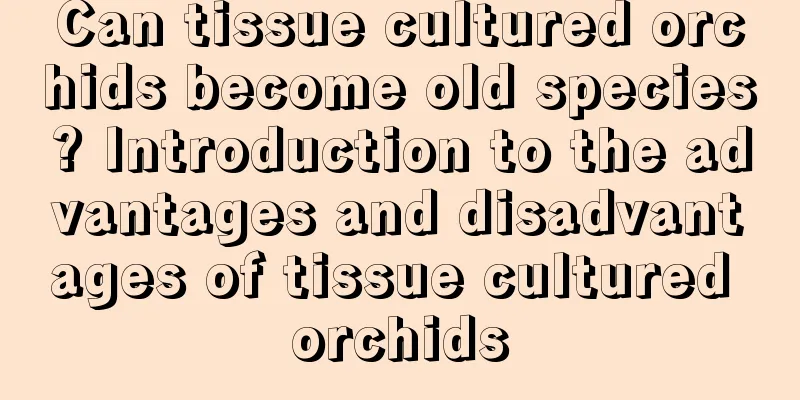Can tissue cultured orchids become old species? Introduction to the advantages and disadvantages of tissue cultured orchids

1. Can it change?Can't become an old species. Old seeds refer to the offspring seedlings obtained by reproduction completely in the natural environment, which can better maintain the characteristics of the original seeds. Tissue culture seedlings are made from mother plants and are artificially cultivated under sterile conditions to cultivate, grow, develop and regenerate complete plants. Therefore, tissue culture seedlings cannot become old varieties. Although both of them use mother plants for reproduction, there are still big differences between them. The roots of tissue culture will be whiter, thinner and smoother than those of old varieties. 2. Advantages and disadvantages of tissue culture1. Advantages: Tissue culture of orchids can allow some precious orchids to be reproduced in large quantities. In addition to being relatively cheap, it can make many rare varieties of orchids accessible to ordinary people. It can also meet the growing demand for orchid seedlings in the market. Otherwise, relying solely on wild seedlings is far from enough to meet the needs of the public. Secondly, tissue culture orchids can be used to cultivate exactly the same orchids, with no difference in flower color and leaf shape. In addition, detoxification can be carried out through tissue culture to make it non-toxic seedlings. 2. Disadvantages: Breeding is difficult. Because tissue culture orchids are cultivated in a sterile environment, the temperature and humidity are strictly controlled. Therefore, its resistance is relatively poor, it has relatively high requirements for temperature and humidity, and it is not resistant to diseases. In other words, it is much more delicate than wild orchids. The quality of tissue-cultured orchids is prone to deterioration, the leaves are shorter, and it is very difficult to bloom. The growth of tissue-cultured orchids is unstable, and they are prone to problems such as short and thin leaves, difficulty in flowering, seedlings falling over, and weak fragrance. In addition, the flower color and leaf shape of tissue-cultured orchids will not change, and they lack individual beauty. Wild orchids are rarely exactly alike; even orchids of the same species on the same mountain will have slight differences due to their different growing locations. |
<<: Breeding techniques for North American alligator turtles
Recommend
What fertilizer is best for crape myrtle?
Crape myrtle fertilization time Generally speakin...
What to do if the leaves of the money tree turn black
Causes of blackening Frost damage The incubation ...
Wheat field management measures in March
As March approaches, wheat in many planting areas...
A complete guide to the reproduction and pest and disease control of spring taro, turning one pot into 10 pots!
Propagation of Spring Taro Reproduction method: T...
How often should you water your apricot tree?
How often should you water your apricot tree? Gen...
Is it profitable to grow flowers and plants? How much profit can you make from growing flowers and plants?
Is planting flowers profitable? Currently, more a...
How to water flowers with fish water
Can fish water be used to water flowers? Fish far...
How often should I water the Master? How long should I water him?
How often should the mage water the water? Spring...
Cultivation methods and precautions of small wine bottle orchid
1. Breeding methods 1. Soil: The bottle orchid is...
How to grow pepper seedlings
1. Seedling raising time Peppers are usually plan...
Selection of rootstock for grafting lollipop rose (grafting rose with Rosa rugosa as rootstock)
The lollipop rose is actually a small tree rose, ...
What to do if the leaves of money tree turn yellow
Water yellow Succulents are cute, but they have s...
How to prune the fortune tree
1. Prepare pruning tools Before pruning, you need...
Potato planting time and method planting method steps
Potato planting time The planting time for potato...
Succulent plants with root rot, leggy growth, black rot... do this and save them in minutes
excessive growth Method 1: Making old piles 1. Fi...









